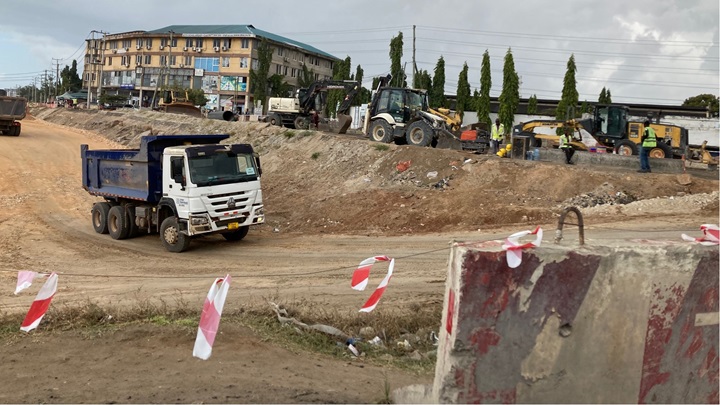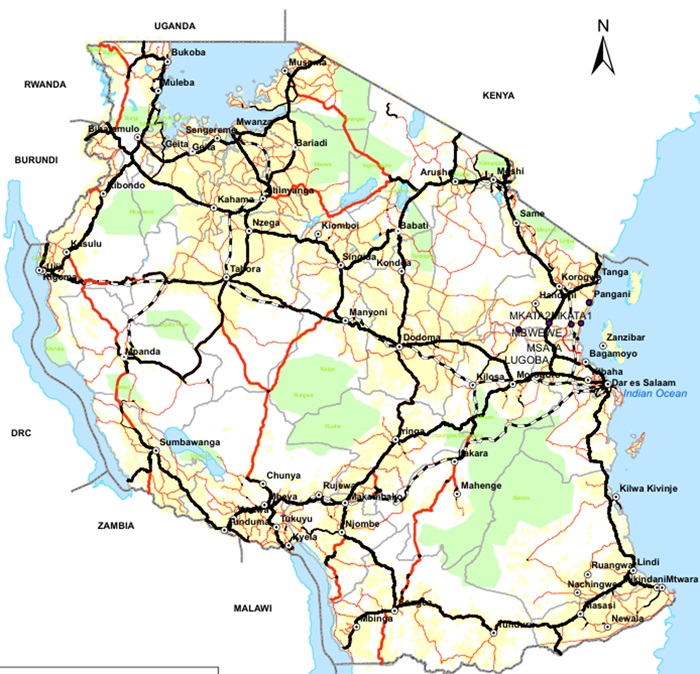Blog Post “Corridor Development and Logistics Facilitation That Are Causing Shifts in Industrial Structure”
2025.07.02
Researchers at the JICA Ogata Sadako Research Institute for Peace and Development (JICA Ogata Research Institute) have wide-ranging experience and diverse backgrounds, and they are forging partnerships with various stakeholders and partners. This series of blog posts shares the knowledge and perspectives that they have acquired through their research activities. Harada Tetsuya , Principal Research Fellow, and Ashida Hana , Research Officer, who work on research on impact evaluation of infrastructure development, wrote this post.
Authors: Harada Tetsuya, Principal Research Fellow, and Ashida Hana, Research Officer, JICA Ogata Research Institute

Rigorous assessment of the impact of infrastructure development is a priority research topic at the JICA Ogata Research Institute. The research project “Structural Transformation, Infrastructure Investment and Industrial Policy in Sub-Saharan Africa
” aims to rigorously examine how past road investments such as international corridor development and relevant trade facilitation policies have impacted changes in industrial structure, employment patterns, industrial agglomeration and land use in each geography. Fieldwork for this project is mainly conducted in Tanzania.
In this blog post, we would like to share insight gained thorough site visits, focusing on the dynamics between road development and industrial growth in Tanzania. We would also like to explain the significance of this research project.
Tanzania is around the center of East Africa and faces the Indian Ocean. Compared to Japan, its land area is about 2.5 times larger and the population is about a half. Its network of major highways consists of the following: highways that start from major ports like the Port of Dar es Salaam, running east to west to landlocked neighbors like Burundi and Rwanda; and highways extending north to south, linking the country with Kenya as well as countries further south such as Zambia. These highways were developed in phases with support from the Tanzanian government, bilateral donors, international organizations and the government of Japan.
These roads have important roles as international corridors. For landlocked countries like Burundi and Rwanda, whose imports and exports rely on maritime transport via Tanzanian ports, the shipment of goods on land depends heavily on the Tanzanian road infrastructure. Tanzania has to develop ports and roads with its own financial resources, thus charges transit fees to landlocked countries. As these landlocked countries have the option of using Kenyan roads and ports instead of Tanzanian ones, Tanzanian and Kenyan ports are effectively in competition with each other.

Cross-border trade also takes place between Tanzania and Kenya. Light-industry products are mainly exported from Kenya to Tanzania, while agricultural and forest products such as wood and grains are exported from Tanzania to Kenya. Our research team visited a one-stop border post (OSBP) in Namanga, a border town situated between Nairobi, which is the capital of Kenya, and Arusha, which is a major city in Tanzania. Japan has provided intensive support to OSBPs, which are facilities to simplify the process for cross-border trade. Without OSBPs, truck drivers had to go through passport control and customs clearance at separate facilities on both sides of the border, often causing long delays. With an OSBP, the whole process can now be completed within a single building. Furthermore, recent improvements have made the process more accessible to small trading companies, further opening the door to intra-regional trade.
In addition to the OSBP visit, our research team had a discussion with experts from the New Partnership for Africa’s Development Coordination of the African Union Development Agency (AUDA-NEPAD) and the East African Community (EAC). These organizations are actively working to standardize trade regulations and promote international corridor development across the region. During the discussion, the experts emphasized the importance of evaluating the total time required for goods to reach their final destinations—including port handling, road transport and border crossing—instead of just tracking time spent at borders. They also pointed out the problem of “one-way loads”, where trucks traveling from ports to landlocked countries are full, but often return nearly empty due to the limited availability of exports from those countries. We hope our research will shed light on how road development affects broader patterns of industrial development.
Road development is important for domestic development in Tanzania as well. Dar es Salaam, the country’s largest city, has an urban population growth rate of 7% per year, one of the highest in Sub-Saharan Africa. As a result, urban transport infrastructure such as bus rapid transit (BRT) is expanding rapidly. Rail network development is also progressing and a passenger and freight rail service between Dar es Salaam and Dodoma, the capital city, just began in July 2024. That said, roads remain a major mode of transportation nationwide. To understand how road investments influence shifts in industrial structure, industrial agglomeration and land use, we visited businesses and authorities and conducted interviews.
Near Dodoma, we visited a business that produces “must,” the freshly pressed grape juice containing the skins, stems and seeds to be fermented to produce wine. It had only four employees and this is the typical scale of Tanzanian businesses. This business has previously received management support through Japanese-style kaizen practices promoted by JICA. The wine industry is growing in Dodoma and with improved transportation networks and some wine exports are now reaching Europe. We felt that the future of the Tanzanian agro-processing industry is promising.
In Arusha, we visited a factory with 7,000 workers, producing daily-use plastic products and sewn products. Production was chiefly for the domestic market, but the factory was equipped with modern machinery capable of mass production. This visit experience reminded us of earlier research findings suggesting the growth of growing polarization in African manufacturing between small businesses with low productivity and capital-intensive businesses with high productivity businesses.

Arusha is also known for its thriving furniture industry. Interviews with businesses revealed that many furniture orders come from hotels, as Arusha is a gateway to famous tourist spots like the Ngorongoro Conservation Area and Mount Kilimanjaro. Another notable factor is labor mobility: the presence of many peer companies enables the movement of skilled workers between different businesses. This reflects classic features of agglomeration economies, and we observed firsthand how theory aligns with reality. In addition, improvements in road networks have expanded the reach of wood procurement and sales, linking businesses to more distant areas than before. This confirms the strong connection between infrastructure and industrial growth.
Agriculture benefits from road network development as well. In Tanzania, thanks to the long-term support from JICA, rice production has increased, and some rice is even exported to neighboring countries. At a training facility in Moshi, a town on the southern foothills of Mount Kilimanjaro, rice cultivation techniques are being shared with farmers from other parts of the country. Production of traditional crops such as maize and cash crops like coffee remains strong. From an academic perspective, it is important to elucidate how changes in crop production and land use are linked to road network development.
Over the past 20 years, Tanzania has recorded one of the highest economic growth rates, stably, among countries in Sub-Saharan Africa. Public investments in infrastructure, such as roads, have fueled this growth not only through increased demand, for example, in the construction sector, but also by facilitating trade and industrial expansion. By conducting fieldwork, we are gaining hands-on experience and strengthening our relationships with relevant Tanzanian authorities, including the National Bureau of Statistics. With access to official data and GIS data such as satellite imagery data, we aim to conduct even more rigorous analyses to better understand the relationship between road development and shifts in industrial structure, ultimately offering policy-relevant insight.
*The views expressed in this publication are those of the authors and do not necessarily reflect those of JICA or the JICA Ogata Research Institute.
Harada Tetsuya
Harada is a Principal Research Fellow at the JICA Ogata Research Institute. His previous roles include economist at the World Bank as well as positions at the JICA Indonesia Office and the Credit Risk Analysis and Environmental Review Department, JICA. Harada started his career at the Overseas Economic Cooperation Fund (OECF), followed by positions at the Japan Bank for International Cooperation (JBIC) and the Japan International Cooperation Agency (JICA), where he was in charge of infrastructure development projects, development policy loans, and private sector finance screening in Southeast Asia and Sub-Saharan Africa. His research interests include development economics, applied econometrics, impact evaluation, industrial structure transformation in developing countries, and infrastructure development.

Ashida Hana
Ashida has been a Research Officer at the JICA Ogata Research Institute since 2022. She previously participated in the Japan Overseas Cooperation Volunteer program in Peru (for community development) and then worked at a general trading company. Ashida’s research interests include development economics and econometrics.


事業事前評価表(地球規模課題対応国際科学技術協力(SATREPS)).国際協力機構 地球環境部 . 防災第一チーム. 1.案件名.国 名: フィリピン共和国.

事業事前評価表(地球規模課題対応国際科学技術協力(SATREPS)).国際協力機構 地球環境部 . 防災第一チーム. 1.案件名.国 名: フィリピン共和国.

事業事前評価表(地球規模課題対応国際科学技術協力(SATREPS)).国際協力機構 地球環境部 . 防災第一チーム. 1.案件名.国 名: フィリピン共和国.

事業事前評価表(地球規模課題対応国際科学技術協力(SATREPS)).国際協力機構 地球環境部 . 防災第一チーム. 1.案件名.国 名: フィリピン共和国.

事業事前評価表(地球規模課題対応国際科学技術協力(SATREPS)).国際協力機構 地球環境部 . 防災第一チーム. 1.案件名.国 名: フィリピン共和国.
scroll